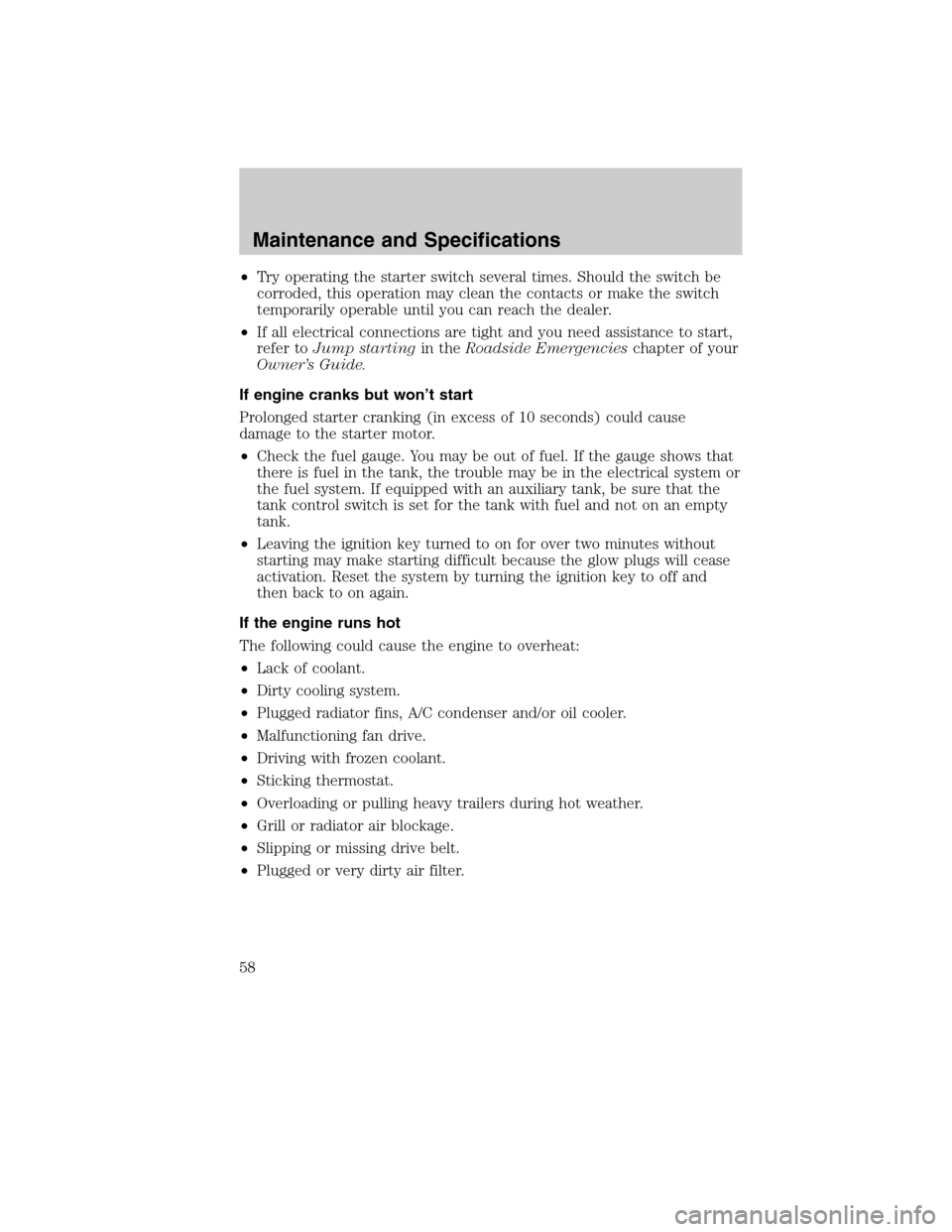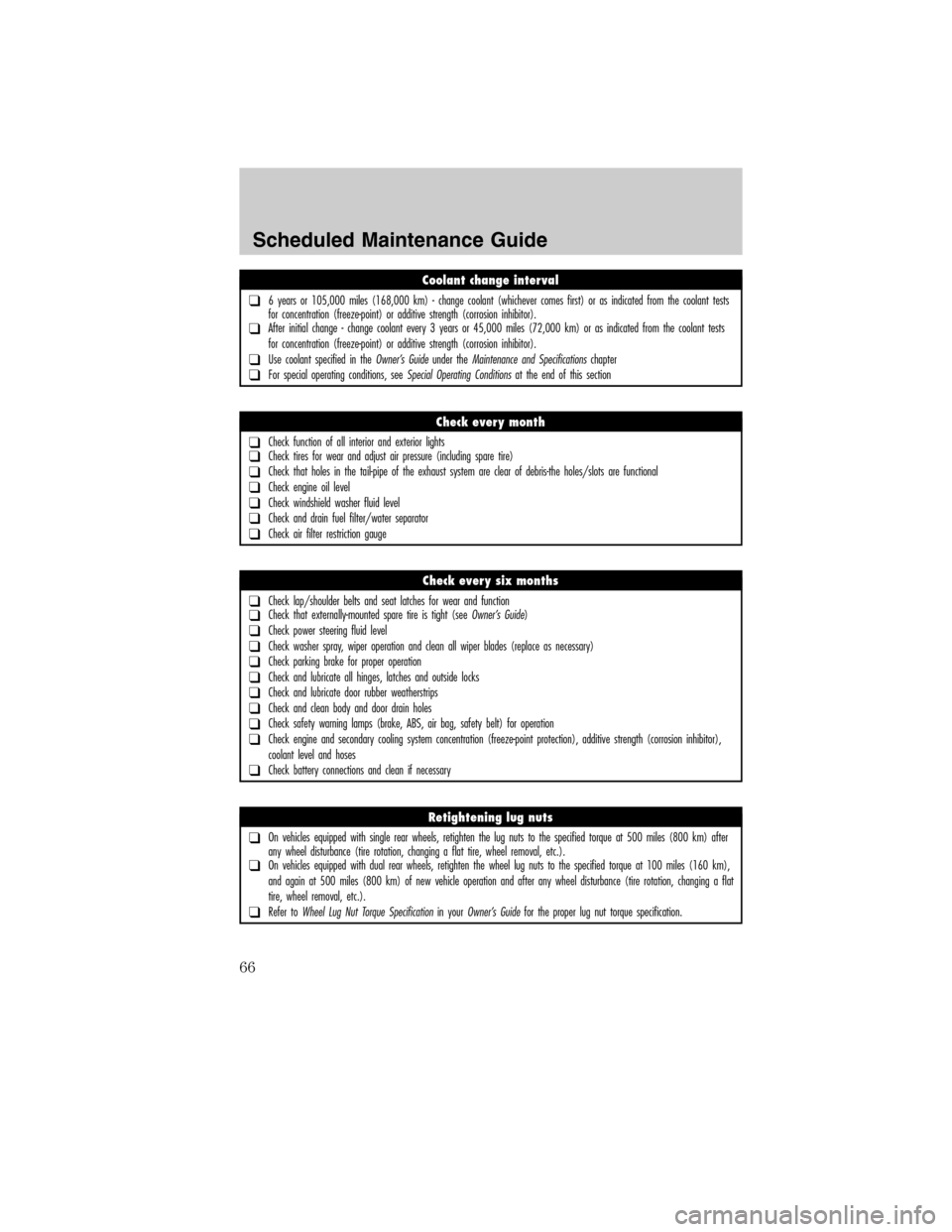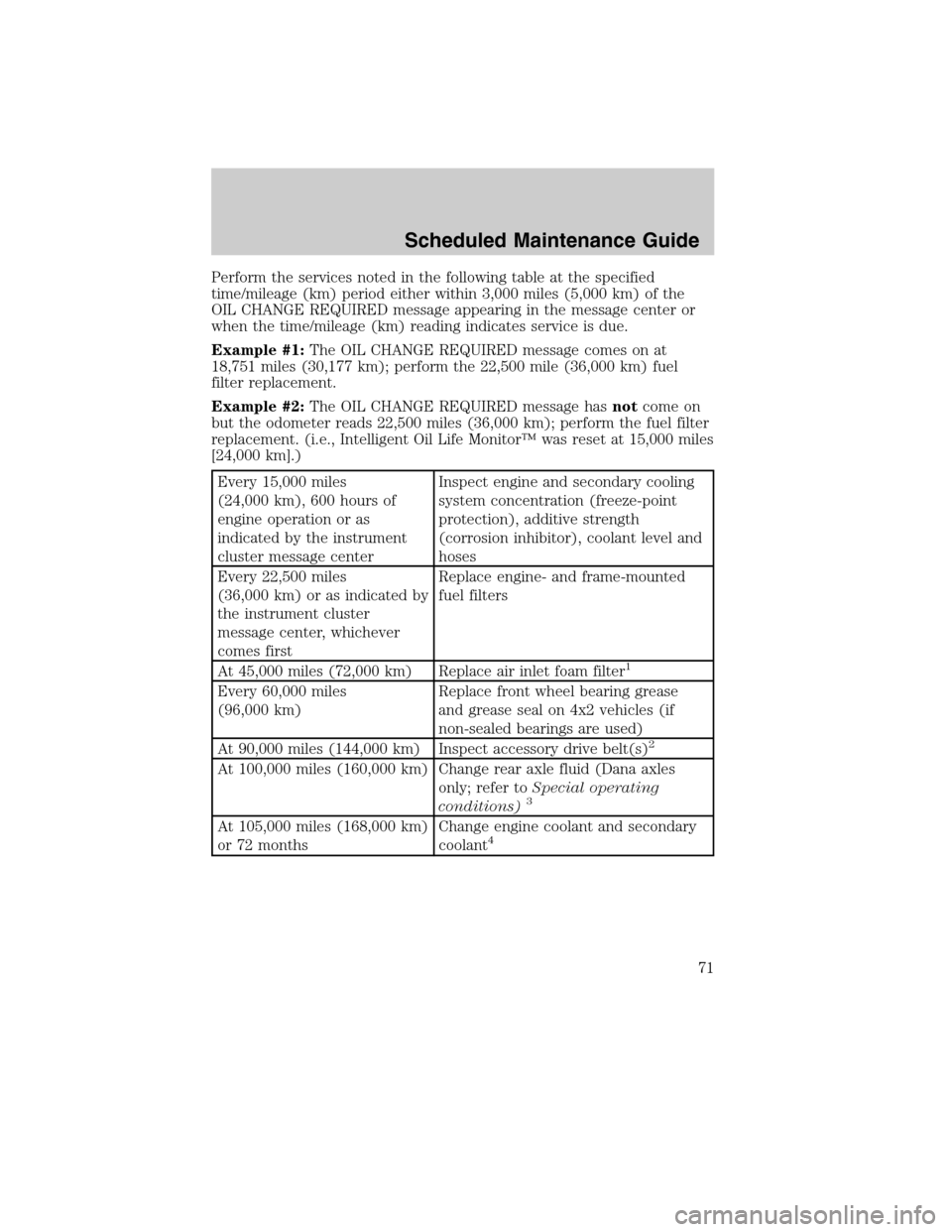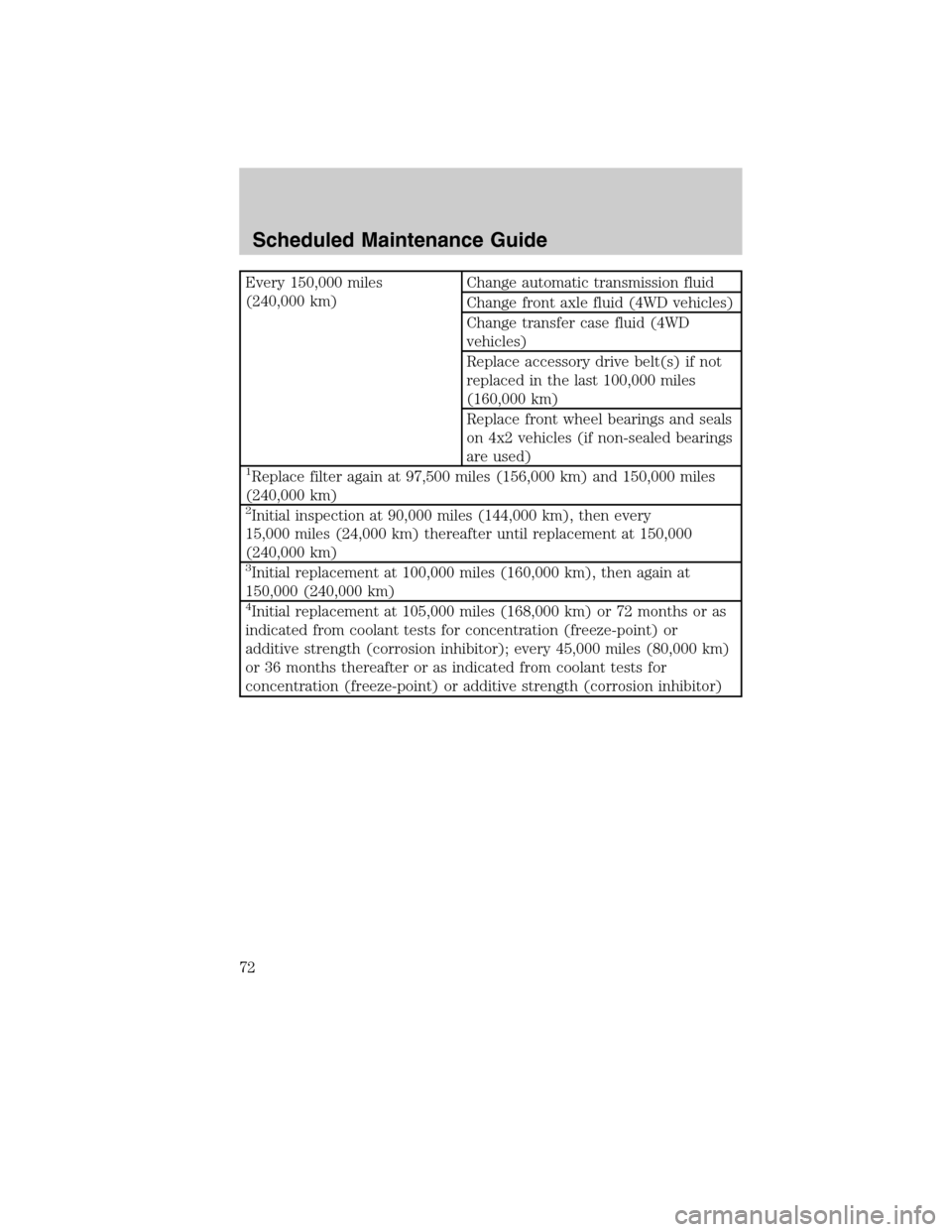Page 58 of 90

•Try operating the starter switch several times. Should the switch be
corroded, this operation may clean the contacts or make the switch
temporarily operable until you can reach the dealer.
•If all electrical connections are tight and you need assistance to start,
refer toJump startingin theRoadside Emergencieschapter of your
Owner’s Guide.
If engine cranks but won’t start
Prolonged starter cranking (in excess of 10 seconds) could cause
damage to the starter motor.
•Check the fuel gauge. You may be out of fuel. If the gauge shows that
there is fuel in the tank, the trouble may be in the electrical system or
the fuel system. If equipped with an auxiliary tank, be sure that the
tank control switch is set for the tank with fuel and not on an empty
tank.
•Leaving the ignition key turned to on for over two minutes without
starting may make starting difficult because the glow plugs will cease
activation. Reset the system by turning the ignition key to off and
then back to on again.
If the engine runs hot
The following could cause the engine to overheat:
•Lack of coolant.
•Dirty cooling system.
•Plugged radiator fins, A/C condenser and/or oil cooler.
•Malfunctioning fan drive.
•Driving with frozen coolant.
•Sticking thermostat.
•Overloading or pulling heavy trailers during hot weather.
•Grill or radiator air blockage.
•Slipping or missing drive belt.
•Plugged or very dirty air filter.
Maintenance and Specifications
58
2011 Econoline(eco)
Supplement, 1st Printing
USA(fus)
Page 62 of 90
ENGINE DRIVEBELT ROUTING
Single Alternator
Dual Alternator
Maintenance and Specifications
62
2011 Econoline(eco)
Supplement, 1st Printing
USA(fus)
Page 66 of 90

Coolant change interval
❑6 years or 105,000 miles (168,000 km) - change coolant (whichever comes first) or as indicated from the coolant tests
for concentration (freeze-point) or additive strength (corrosion inhibitor).
❑After initial change - change coolant every 3 years or 45,000 miles (72,000 km) or as indicated from the coolant tests
for concentration (freeze-point) or additive strength (corrosion inhibitor).
❑Use coolant specified in theOwner’s Guideunder theMaintenance and Specificationschapter
❑For special operating conditions, seeSpecial Operating Conditionsat the end of this section
Check every month
❑Check function of all interior and exterior lights❑Check tires for wear and adjust air pressure (including spare tire)
❑Check that holes in the tail-pipe of the exhaust system are clear of debris-the holes/slots are functional
❑Check engine oil level
❑Check windshield washer fluid level
❑Check and drain fuel filter/water separator
❑Check air filter restriction gauge
Check every six months
❑Check lap/shoulder belts and seat latches for wear and function❑Check that externally-mounted spare tire is tight (seeOwner’s Guide)
❑Check power steering fluid level
❑Check washer spray, wiper operation and clean all wiper blades (replace as necessary)
❑Check parking brake for proper operation
❑Check and lubricate all hinges, latches and outside locks
❑Check and lubricate door rubber weatherstrips
❑Check and clean body and door drain holes
❑Check safety warning lamps (brake, ABS, air bag, safety belt) for operation
❑Check engine and secondary cooling system concentration (freeze-point protection), additive strength (corrosion inhibitor),
coolant level and hoses
❑Check battery connections and clean if necessary
Retightening lug nuts
❑On vehicles equipped with single rear wheels, retighten the lug nuts to the specified torque at 500 miles (800 km) after
any wheel disturbance (tire rotation, changing a flat tire, wheel removal, etc.).
❑On vehicles equipped with dual rear wheels, retighten the wheel lug nuts to the specified torque at 100 miles (160 km),
and again at 500 miles (800 km) of new vehicle operation and after any wheel disturbance (tire rotation, changing a flat
tire, wheel removal, etc.).
❑Refer toWheel Lug Nut Torque Specificationin yourOwner’s Guidefor the proper lug nut torque specification.
Scheduled Maintenance Guide
66
2011 Econoline(eco)
Supplement, 1st Printing
USA(fus)
Page 71 of 90

Perform the services noted in the following table at the specified
time/mileage (km) period either within 3,000 miles (5,000 km) of the
OIL CHANGE REQUIRED message appearing in the message center or
when the time/mileage (km) reading indicates service is due.
Example #1:The OIL CHANGE REQUIRED message comes on at
18,751 miles (30,177 km); perform the 22,500 mile (36,000 km) fuel
filter replacement.
Example #2:The OIL CHANGE REQUIRED message hasnotcome on
but the odometer reads 22,500 miles (36,000 km); perform the fuel filter
replacement. (i.e., Intelligent Oil Life Monitor™ was reset at 15,000 miles
[24,000 km].)
Every 15,000 miles
(24,000 km), 600 hours of
engine operation or as
indicated by the instrument
cluster message centerInspect engine and secondary cooling
system concentration (freeze-point
protection), additive strength
(corrosion inhibitor), coolant level and
hoses
Every 22,500 miles
(36,000 km) or as indicated by
the instrument cluster
message center, whichever
comes firstReplace engine- and frame-mounted
fuel filters
At 45,000 miles (72,000 km) Replace air inlet foam filter
1
Every 60,000 miles
(96,000 km)Replace front wheel bearing grease
and grease seal on 4x2 vehicles (if
non-sealed bearings are used)
At 90,000 miles (144,000 km) Inspect accessory drive belt(s)
2
At 100,000 miles (160,000 km) Change rear axle fluid (Dana axles
only; refer toSpecial operating
conditions)
3
At 105,000 miles (168,000 km)
or 72 monthsChange engine coolant and secondary
coolant4
Scheduled Maintenance Guide
71
2011 Econoline(eco)
Supplement, 1st Printing
USA(fus)
Page 72 of 90

Every 150,000 miles
(240,000 km)Change automatic transmission fluid
Change front axle fluid (4WD vehicles)
Change transfer case fluid (4WD
vehicles)
Replace accessory drive belt(s) if not
replaced in the last 100,000 miles
(160,000 km)
Replace front wheel bearings and seals
on 4x2 vehicles (if non-sealed bearings
are used)
1Replace filter again at 97,500 miles (156,000 km) and 150,000 miles
(240,000 km)
2Initial inspection at 90,000 miles (144,000 km), then every
15,000 miles (24,000 km) thereafter until replacement at 150,000
(240,000 km)
3Initial replacement at 100,000 miles (160,000 km), then again at
150,000 (240,000 km)
4Initial replacement at 105,000 miles (168,000 km) or 72 months or as
indicated from coolant tests for concentration (freeze-point) or
additive strength (corrosion inhibitor); every 45,000 miles (80,000 km)
or 36 months thereafter or as indicated from coolant tests for
concentration (freeze-point) or additive strength (corrosion inhibitor)
Scheduled Maintenance Guide
72
2011 Econoline(eco)
Supplement, 1st Printing
USA(fus)